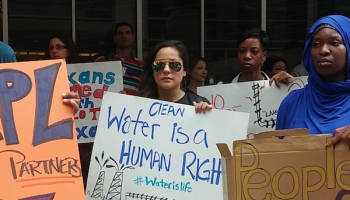Ecology Center helped create a Lead Commission to end lead poisoning in Michigan

Michigan Ranked One of the Worst States for Childhood Lead Poisoning.
In 2016, the Flint Water Crisis brought renewed attention to the critical issue of childhood lead poisoning in Michigan and throughout the United States. Even before the Flint crisis, Michigan was one of the worst states in the nation for childhood lead poisoning. Like many states in the Great Lakes, Michigan has a history of heavy industrial pollution, old housing stock, lead service lines in many communities, and crumbling infrastructure. These factors are closely linked to high rates of elevated blood lead levels. We believe that Michigan must commit to eliminating lead from all preventable sources within a specific timeframe.
In 2013, the Centers for Disease Control and Prevention ranked Michigan the fifth-worst state in the nation for its rate of childhood lead poisoning.
In 2014, the Ecology Center released “Economic Impacts of Lead Exposure and Remediation in Michigan,” the first state-wide analysis of the costs of lead contamination in Michigan conducted by Tracy Swinburn of the University of Michigan and led by the Ecology Center. The report estimated that childhood lead exposure costs for Michigan residents and estimated the benefits of an investment in the remediation of lead paint-based hazards in homes that would pay for itself after three years when compared with the ongoing costs associated with exposure.
In 2016, the Ecology Center updated the report and released “Costs of Lead Exposure and Remediation: Update”, which found that while lead poisoning is a massive public health issue, it is not insurmountable. While the lead poisoning of Michigan’s children has cost the state at least $270 million per year, $112 million of which is paid by taxpayers, there are cost-effective steps that we can take immediately. The report found that a $600 million investment by the state to remediate lead in Michigan’s 100,000 most at-risk homes would likely reduce lead in children by 70%. This would free up money that Michiganders needlessly spend on the aftermath of an inexcusable public health crisis. The investment would return $190 million annually, $78 million of which would be saved by Michigan taxpayers. It could also address an epidemic of behavioral issues in children. As cited in the report, 21.1% of ADHD cases have been associated with elevated blood lead levels. 15% of adult crime has been associated with lead exposure and 10% of juvenile delinquency.
In the wake of the Flint Water Crisis, and following on the reports, the Ecology Center and a coalition of health and environmental groups demanded the state government end lead poisoning in Michigan’s children
At the urging of the Ecology Center and its allies, the State of Michigan set up the Childhood Lead Exposure Elimination Commission. We now have a seat at the table of Michigan’s Lead Commission, which has issued a set of recommendations to end lead poisoning in the State. The Commission has also provided funding to local health departments to investigate lead risks, and provided funding for 11 different innovative pilot projects across the state to stop lead poisoning before it starts. We worked with Wayne County to evaluate the existing lead remediation programs and to make recommendations on improving and accelerating the work there. We do all of this work with our allies in the lead poisoning prevention community in Michigan, including our colleagues with the Michigan Alliance for Lead Safe Homes.
We continue to work with state and local decision-makers to support public policies that aim to end childhood lead poisoning and to push for best practices to protect kids from lead poisoning. We are currently supporting a program called Filter First! To provide lead filters for Michigan schools so children are not exposed to lead at school.

